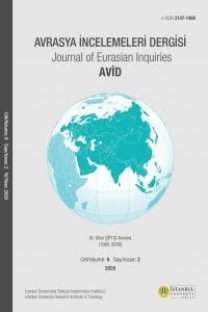Epik Miras - Altın Hazine
Makale, Orta Asya'da ulusal tiyatro sanatının gelişiminde halk sanatı mirasının rolü ve önemini tartışıyor. Bugüne kadar bölgenin tiyatro sanatı büyük bir deneyime sahip ve kültürünü başkalarıyla karşılaştırma imkânı buluyor. Destansı yön, tiyatro sanatı dünyasının deneyimlerine ve trendlerine bakabileceğiniz yüksekliklerden biri olan destek noktalarından biridir. Halk destanlarında, kültür ve maneviyatın çeşitli unsurları izlenir ve belirli bir milliyetin özellikleri ortaya çıkarılır. Avrupa tiyatro tarzının Orta Asya kültürü çerçevesine girmesi, halkın geleneksel tiyatrosunun gelişimini kesinlikle etkiledi. Yaratıcı figürler performanslarını kapalı sahnelerde odalarda sergileme sorunuyla karşılaştı. Parçalarda halk gelenekleri ortak bir örüntü izlenerek sunulurken, ulusal tiyatrolar kültürü, gelenekleri ve milletin geçmişini yansıtan kendi yorumlarını sunar. Farklı uluslar tarafından yaratılan aynı başlık ve konunun esasen farklı parçaları, üslup, yöntem, sanatsal temsil ve karakter yorumu açısından farklılık göstermekle kalmaz ve asla bir ulusun kahramanı, komşu ulusun yarattığı görüntünün tekrarı değildir. Bu, milletin zihniyetinin, kültürünün, manevi karakterinin ve geleneksel değerlerinin ortaya çıkma şeklidir. Bu da tiyatroların gelişiminde baskın bir özelliktir. Destansı miras, Orta Asya'nın teatral kültürünün altın hazinesi olarak hizmet ediyor.
Anahtar Kelimeler:
Orta Asya, destan, tiyatro, halk sanatı, kültür, dönüşüm, yöntem, tarih, gelenek, akımlar
Epic Heritage - The Gold Treasure
The article discusses the role and importance of folk art heritage in the development of national theater art in Central Asia. To date, the theatrical art of the region has a great experience and it has the opportunity to compare its culture with others. The epic direction is one of the points of support, one of the heights from which you can look at the experience and trends of the world of theatrical art. In folk epics, various elements of culture and spirituality are traced, and the peculiarities of a particular nationality are revealed. The entry of the European style of theater into the framework of the culture of Central Asia certainly influenced the development of traditional theater of the people. Creative figures faced the problem of showing their performances on closed stages, in rooms. In the pieces, folk customs are presented following a common pattern, whereas national theatres offer their own interpretation, reflecting the culture, customs, and the nation’s past. Not only essentially different pieces of the same title and subject, created by different nations, differ in style, methods, means of artistic representation and character interpretation, and never a hero of one nation is a repetition of the image created by the neighboring nation. This is how the nation’s mentality, culture, spiritual character, and traditional values are exposed. This, in turn, is a dominant feature in the evolution of theatres. The epic heritage serves as the golden treasure of the theatrical culture of Central Asia.
Keywords:
Central Asia, epic, theatre, folk art, culture, transformation, method, history, tradition, trends,
___
- Aitmatov CH. The Shining peak of the ancient Kyrgyz spirit. In the book «Encyclopedic phenomenon of the epic «Manas». – Bishkek: «Muras», 1995. - 472s.
- Rakhmanov M. Uzbek Theater from ancient times to 1917. - Tashkent: Nauka, 1981. - 430 p.
- Aristotle. Poetics. - Tashkent: Literature and art, 1980. - 152s.
- Klyuyev V. Theatrical and aesthetic views of Brecht. - Moscow: Nauka, 1966. - 183p.
- Stanislavsky K. My life in art. - Tashkent: Literature and art, 1965. - 246 p.
- Vakhtangov E. On the way to Turandot. - Moscow: Zebra-E, 2010. - 368 p.
- Fraser J. Folklore in the old Testament. - Moscow: Politizdat, 1985, 511 p.
- Zhirmunsky V. Introduction and study of the epic «Manas». In the collection «Kyrgyz heroic epic «Manas» - Moscow: Publishing house of the Academy of Sciences USSR, 1961. - 378 p.
- «Zuhra-Takhir». GazetaTurkmenskaya spark. 1926, 1 November.
- Korogli H. Interrelations of the epos of the peoples of Central Asia, Iran and Azerbaijan. - Moscow: Nauka, 1983. - 240 p.
- Kaidalova O. Traditions and Modernity. Theatrical art of Central Asia and Kazakhstan. - Moscow: Iskusstvo, 1977. – 296 p.
- Kabdieva S. Folklore traditions in the Kazakh theater. - Alma-Ata: Oner, 1986 .- 112 p.
- Mirzaev T. Epos and storyteller. - Tashkent: Fan, 2008.- 410 p.
- Qodirov M. O`zbek teatri an`analari. - Toshkent: Fan, 1976. - B. 422.
- Qodirov M. O`zbek xalq tomosha san`ati. - Toshkent:O`qituvchi, 1981. - B. 224.
- Qodirov M. Tomosha san`ati o`tmishidan lavkhalar. - Toshkent: Fan, 1993. - B. 205.
- Qodirov M. O`zbek an`anaviy teatri. - Toshkent: Uzbekiston Milliy kutubhonasi nashriyoti, 2010. - B.468.
- Qodirov M. Tomosha san`atlari o`tmishda va bugun. 1- volume. - Toshkent: Mumtoz so`z, 2011 .- B. 528.
- Manas destani ve etkileri uluslararasi bilgi soleni. – Ankara: Ataturk kultur merkezi, 1995. – 330 s.
- Јуезов М. Thoughts of many years. - Almaty: Jalin, 1961. –542 p.
- Yayın Aralığı: Yılda 2 Sayı
- Başlangıç: 2012
- Yayıncı: İstanbul Üniversitesi
Sayıdaki Diğer Makaleler
ABD’den Rusya’ya ve Rusya’dan Dünyaya Bakış Bir Jeopolitik Satranç İncelemesi
Sabır'ın Ulusal Rönesans Ülküsü ("SOSYAL ÜST KADEMELER"E ILIŞKIN BAKIŞ AÇISI BAĞLAMINDA)
Sabır'ın Ulusal Rönesans Ülküsü ("SOSYAL ÜST KADEMELER"E ILIŞKIN BAKIŞ AÇISI BAĞLAMINDA)
Türk Yurdu Dergisinde Rusya Türkü Yazarlar, Fikirleri ve Türklüğe Katkıları
